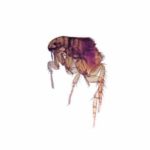 Many pet owning vacationers may return home to discover an unexpected flea infestation awaiting them. Although it seems the fleas came from nowhere, the truth is …. they were always there. The adult flea is the most visible stage but there are also eggs, larva and pupa aspects to consider.
Many pet owning vacationers may return home to discover an unexpected flea infestation awaiting them. Although it seems the fleas came from nowhere, the truth is …. they were always there. The adult flea is the most visible stage but there are also eggs, larva and pupa aspects to consider.
The “sudden appearance” of fleas is the result of the pupa or cocoon stage. Once the cocoon is completed a “trigger” is required for the adult to emerge. The adult flea may emerge in as little as five days or it may wait for nearly a year depending on the environment. The “triggers” the flea is waiting for include movement, heat or carbon dioxide, all of which indicate a meal is nearby.
Adult fleas typically spend all their lives on a host feeding at will and producing “flea dirt”, dried blood. After a blood meal the female flea lays eggs which fall off of the host, along with the flea dirt. Upon hatching from eggs the larvae seek a dark place to hide and the flea dirt which they eat.
Once the larva is fully grown it encases itself in a cocoon of sticky silk that collects various bits of debris. This pupa stage, in addition to causing “sudden high flea populations”, also causes difficulties in achieving control because the layer of debris provides insulation from pesticides.
The movement, heat and carbon dioxide introduced into a previously still environment triggers the emergence of any number of adult fleas when a pet owning family returns home from vacation. Upon emerging the adult flea is eager to feed and will jump onto the first warm blooded host it can find. Although fleas prefer animal hosts, they will not be picky at this time and certainly wont just wait for the pets to return from boarding.
Although flea control is a complicated and involved process, it is possible to achieve it with the assistance of the homeowner. If you should be experiencing a flea problem, we hope you will put the expertise and resources of Mr. Bugg’s Pest Patrol to work on your behalf.
Call today for a FREE evaluation.

